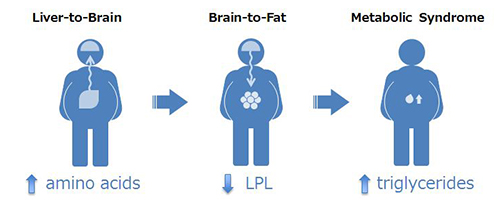A neuronal relay system offers a new therapeutic strategy for obesity-related hypertriglyceridemia
Researchers at Tohoku University have discovered a communication pathway between the brain, fat and the liver that plays a critical role in obese people developing hypertriglyceridemia, a condition characterized by increased blood levels of fatty substances known as triglycerides. These findings could be important for the development of new therapies that reduce or prevent the risk of patients with hypertriglyceridemia developing atherosclerosis and cardiovascular disease.
Previous studies have shown that excess dietary protein that enters the liver as amino acids can cause hypertriglyceridemia, but little is known about the mechanism involved. Hideki Katagiri at Tohoku University Graduate School of Medicine and colleagues have identified a messenger system that regulates these amino acid and triglyceride levels. They found that neuronal signals convey nutritional information in the liver to adipose tissue, which decreases expression of adipose lipoprotein lipase, the protein responsible for breaking down triglycerides and enabling the uptake of fat into tissues 1.
This is not the first time the authors have examined the role of neuronal signals in mediating communication between the liver and other parts of the body. In 2008, they showed how neuronal signals from the liver induce beta cell proliferation in the pancreas 2 . But their most recent results took them by surprise. "Although we expected that neuronal signals would mediate some interesting phenomena in other tissues, hypertriglyceridemia was totally unexpected," says Katagiri.
To mimic the conditions found in some patients with obesity, the authors generated a transgenic mouse model with high levels of amino acids in the liver. As previously reported in patients with obesity, the intracellular mechanistic target of rapamycin complex 1 (mTORC1) and S6kinase (S6K) signaling pathway was activated in the liver of these mice and high levels of blood triglycerides were observed, especially after feeding.
When the researchers removed the nerve connections that link the liver to the brain, known as the afferent vagus, or blocked the sympathetic nerves that innervate adipose tissue, hypertriglyceridemia did not develop.
Through further genetic and pharmacological analyses, the authors showed that upon activation of mTORC1-S6K signaling in the liver and a high fat intake, the neuronal relay system causes a decrease in expression of lipoprotein lipase in adipose tissue and thus, a decrease in the breakdown of triglycerides.
"Neuronal relay systems are important for the development of many key features of the metabolic syndrome," says Katagiri. Understanding the mechanisms mediating inter-tissue communication to coordinate nutrient metabolism will lead to much needed therapies for common conditions such as hyperinsulinemia, hypertension and obesity.
 |
|
Researchers at Tohoku University discover a neuronal messenger system that plays a critical role in obese people developing a metabolic syndrome characterized by hypertriglyceridemia. Nutritional information about excess dietary proteins entering the liver as amino acids is transmitted to the brain. The brain then relays that information to fat tissue, which suppresses expression of a protein responsible for breaking down triglycerides, known as adipose lipoprotein lipase (LPL). |
- References:
- 1. Uno, K. et al. A hepatic amino acid/mTOR/S6K-dependent signalling pathway modulates systemic lipid metabolism via neuronal signals. Nature Communications 6, 7940 (2015).
http://dx.doi.org/10.1038/ncomms8940- 2. Imai, J. et al. Regulation of pancreatic beta cell mass by neuronal signals from the liver. Science 322, 1250-1254 (2008).
http://dx.doi.org/10.1126/science.1163971
Contact:
Hideki KatagiriTohoku University Graduate School of Medicine
Email: katagiri
 med.tohoku.ac.jp
med.tohoku.ac.jp
